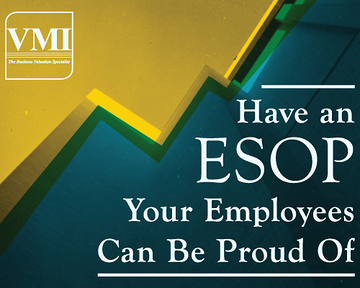
Some of the most successful companies have become so by providing proper incentives to their employees.
One such incentive is an Employee Stock Ownership Plan (“ESOP”), a defined benefit retirement plan. With properly employed ESOPs, these companies have been shown to outperform similar companies without ESOPs. ESOP give employees a vested interest in the company’s performance.
While growth in the company’s stock is always the end goal and has its own positive impact, the most successful ESOPs get maximum results by creating a culture of employee ownership and empowerment.
Establishing an ownership culture that engages employees can result in higher productivity, profitability, and customer ratings as well as lower turnover, less absenteeism, and a better safety record. Engaged employees are enthusiastic about their jobs and more likely to drive innovation, growth, and revenue.
The road to developing an employee ownership culture starts with education and communication.
Education: Early & Often!
The education process should start early and cover the basics – what is an ESOP?; how does it work?; and what’s in it for the employee-owner? Explain it from the participant’s point of view and encourage questions.
Ongoing education and communication is critical to address any issues that may arise. While it’s important to ensure that new hires are brought up to speed on the ABCs of an ESOP, it’s equally important to realize that existing employees have different questions and concerns. Many companies form ESOP committees to spread the responsibilities throughout the entire organization and facilitate the education process.
The more your employees understand their impact as owners, the more engaged they will be in the successful operation of the company. The end goal of education is to help the employee to understand and embrace the link between job performance and the value of the company’s stock.
Employees’ suggestions, ideas, and efficiencies can impact revenue and profitability. This, in turn, can have a positive impact on value.
What’s happening?!
Ownership has certain rights, including some level of access to information. Some companies are very proactive and choose to share more information with the participants. It may make sense to start simply by communicating the company’s financial performance and what factors have impacted it.
While not all of the participants will be financially sophisticated, they will all benefit by knowing the good, the bad and the ugly and what influenced each outcome. Openly discussing issues impacting sales, productivity and profitability will help solidify the ownership culture and further engage the employees in the business.
Who, me?
Being an employee owner is not all take.
The employee owner is also asked to give a high level of responsibility to the company. Employee owners are called to make recommendations that will improve the company, maintain high quality standards, reduce unnecessary expenses and work efficiently and safely.
Fulfilling one’s responsibilities will contribute to the company’s overall success.
Communicating Value
The ESOP is the employee’s retirement benefit. Rather than just handing out year-end statements to participates, it is important to properly communicate the concept of value to them.
Understanding what contributes to/detracts from value can only help employee owners to do what they can to improve the stock price. Participants need to be made aware of the correlation between the stock value and the retirement benefit.
Value is dependent on both internal and external factors.
Stock value may increase in a leveraged company by merely paying down the company’s debt. Communicating the factors that the company and the employees can control and impact, can produce greater increases in value and greater retirement benefits.
The factors having the greatest impact on value include profitability and growth. Every employee can be integral to a company’s profitability. For example, building and maintaining a reputation for on-time delivery can help a company stand above the competition or command a higher selling price on your products.
Finding ways to increase productivity and eliminate waste becomes everybody’s responsibility. Growth is impacted by reputation, competition, market expansion, innovation, quality, and service.
Stock values can go up or down. It’s not only important to share the good news but also to explain, discuss and answer questions about the bad news.
Communication helps engage the workforce. With a vested interest, an engaged staff will be more devoted to finding ways to help improve value.
It takes a village
Don’t reinvent the wheel! Take advantage of the success achieved by other ESOP companies with well-established ESOP cultures that have resulted in high employee morale and satisfaction.
These companies have already tried different avenues and have ultimately discovered what forms of communication, education and engagement that have worked best for their workforce.
The ESOP community is tight knit and always willing to share.
The ESOP Association and the National Center for Employee Ownership have national, regional and local conferences and education programs.
The ESOP companies that attend are more than willing to share their successes and how they have promoted and benefited from the ESOP. Whether you are a manufacturer with large production staff, a service organization with Ph.ds, or a construction company with staff spread out geographically, you’ll probably be able to find a company facing similar issues that has found the key to successfully engaging their employee/owners.
Summary
According to Gallup, only one in eight employees worldwide is truly engaged at work, while 63 percent are “not engaged” and one in four is “actively disengaged.”
Establishing an ESOP is only the first step to engaging employees. The best results are produced by creating a culture of employee ownership and empowerment. This takes time, effort and dedication from the company, its management team and its staff.
Engaged ESOP employees are enthusiastic about their jobs and more likely to drive innovation, growth, and revenue. This will result in an increase in employee satisfaction and improved shareholder value.

